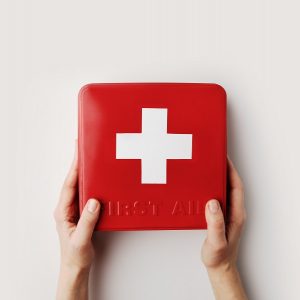Food Allergy Prevention
At risk children
The prevalence of allergies in children is around 6%. Combinations of genetic and environmental factors contribute to the risk of developing an allergic condition. The term atopy describes this predisposition. Infants who have severe eczema have a high risk of developing a food allergy. Infants with mild to moderate eczema, those with a family history of atopy in one or both parents (food allergies, allergic rhinitis, eczema, asthma), or those who already have a known food allergy are also more at risk of developing a food allergy (or an additional one).
It is impossible to predict the type of allergy a child will develop, but it has been observed that the more direct the degree of kinship, the more likely the child is to develop an atopic condition. In some cases, the child will have the same condition has their allergic relative, but it is also possible that the condition manifests itself in a completely different way.
When both parents have an allergy, the risk of their child developing an IgE-mediated allergy is 50% to 60%.
The following is a summary of recent data on the prevention of food allergies in children during pregnancy, breastfeeding, and the introduction to solid foods.
Pregnancy and food allergy prevention
Even if the child is considered at risk of developing food allergies, research shows that a diet that eliminates the main allergens (priority allergens) from the mother’s diet does not have preventive benefits for the child. Of course, a mother that has food allergies herself will follow a diet adapted to her restrictions.
Conclusion: Maternal avoidance of priority allergens, for the sake of allergy prevention, is not recommended during pregnancy.
Breastfeeding and food allergy prevention
Health professionals recommend exclusive breastfeeding for the first four to six months of an infant’s life, until solid foods are added to their diet. Breast milk will then continue to provide as much as half of the baby’s nutritional needs. Until the age of one year, milk should be the baby’s main food. According to the Canadian Paediatric Society, breastfeeding should be continued up to 2 years and beyond, because of its immunological and developmental benefits.
While breastfed babies cannot be allergic to breast milk, they could react to certain proteins consumed by the mother and transmitted through breast milk.
__
Peanut Allergy Study (December 2020):
According to The Child Cohort Study eating peanuts while breastfeeding, combined with introducing peanuts to children in their first year, may reduce their risk of peanut allergy by the age of five.
“We did not see a direct beneficial association for breastfeeding alone in relation to peanut sensitization,” explains Dr. Azad, the study’s senior author. “However, the combined effect of all three exposures seemed to offer an enhanced protection against peanut sensitization and future allergy risk.”
____
Conclusion: With respect to the most common food allergens, no dietary restrictions are recommended during breastfeeding. However, if a reaction to the proteins in breastmilk is suspected, it is important to assess the situation with a health professional and modify the mother’s diet if necessary.
Breast milk contains:
- easily digestible protein
- fatty acids, such as DHA (an omega-3 fatty acid) and ARA (an omega-6 fatty acid)
- DHA and ARA promote, among other things, normal growth of the brain, eyes, and nerves, especially in children under two years of age
- cholesterol, which would make the child more likely to regulate their cholesterol level in adulthood
- an abundant amount of lactose, facilitating calcium absorption
- iron and zinc in an easily absorbed form
- minerals (including sodium and potassium) in sufficient quantities and in doses not harmful to the child’s kidney system
- enough water to keep the child hydrated (no need for giving extra water)
- a wide range of vitamins.
In Canada, it is recommended to supplement the breastfed child’s diet with 400 IU of vitamin D per day from birth, as breast milk would not contain enough vitamin D to prevent rickets. Vitamin B12 supplementation may be suggested for a breastfeeding vegan mother.
Breast milk contains antibodies that protect the child:
- against many bacterial and viral infections, including respiratory and gastrointestinal infections and ear infections
- against certain pathogens
- against the multiplication of harmful bacteria thanks to the Bifidus factor, which contributes to the formation of the intestinal flora
- against staphylococci and other bacteria with lactoferrin protein.
Whether your baby is breastfed or bottle-fed, download this baby feeding journal (PDF) (in French) to keep track of his or her eating habits.
Commercial infant formula and prevention of food allergies
The first six months
The child’s immune and digestive systems undergo their most important maturation during the first six months of life. The latest American and European guidelines, as well as the Canadian Paediatric Society , recommend exclusive breastfeeding until the introduction of solid foods. When breastfeeding is not possible, current guidelines suggest the use of highly hydrolyzed formulas for at-risk children as those formulas may prevent the development of allergies. The Canadian Paediatric Society tempers this by noting that “There is limited evidence to suggest that childhood allergy can be prevented in high-risk infants by using certain hydrolyzed cow’s milk formulas in the first four to six months of life, compared with intact cow’s milk formula.”
Commercial infant formula, like breast milk, will be the infant’s main food until the introduction of solid foods, at which point it will continue to complement the child’s nutrition.
Choosing the right commercial infant formula can be difficult. A doctor, allergist or nutritionist specializing in food allergies can assist you with the decision. The cost of special preparations must also be considered. It should be noted that these are not usually reimbursed by provincial drug plans when used as a preventive measure.
If the allergy is confirmed and a commercial preparation adapted to your child’s diet is prescribed by a health professional, most provincial drug plans will offer you a reimbursement.
The different types of commercial formula available
The list below summarizes the current state of research on different types of infant formula related to food allergy prevention.
1. Hydrolyzed commercial formulas (highly and partially hydrolyzed)
Hydrolyzed formulas are safe for infants who are either at risk or not at risk of developing food allergies. However, a significant compilation of data suggests that these formulas should not be recommended as a way of preventing food allergies.
2. Amino acid-based commercial formulas
Amino acid-based formulas are used for the treatment of severe allergies when a baby shows signs of intolerance to highly hydrolyzed formulas. Amino acid-based formulas are not used as a preventive measure.
3. Soy-based preparations
Commercial soy-based formulas are not used as a preventive measure.
4. Ordinary commercial preparations
Commercial intact milk protein-based formulas are not used as a preventive measure.
Here is a list of the different brands of commercial formula; it should be discussed with your healthcare professional, based on your child’s needs.
From the sixth to the twelfth month
Commercial formulas
For children bottle-fed with commercial formulas, continue offering the same formula or try a more economical option or one that better suits the needs of your family. It is important to validate this choice with a health professional.
Cow’s milk
3.25% M.F. cow’s milk can be introduced between 9 and 12 months of age, once the child eats a variety of solid foods from all food groups. Consult Better Living for more details.
Plant-based beverages (rice, oat, soy, etc.)
Before the age of two, it is not recommended to replace cow’s milk, breast milk or commercial formula with plant-based beverages (rice, oat, soy, etc.) unless recommended by a nutritionist. These beverages do not contain enough nutrients (including fat and protein) to meet the child’s nutritional needs for growth and development.
Introduction of solids and prevention of food allergies
From the sixth to the twelfth month (or from the fourth month for some babies*)
Introduction of solid foods, including allergens, is recommended at about six months of age. Most babies are ready to eat pureed foods at the age of 4 to 6 months. Continue to offer breast milk or formula before solids until 9 to 12 months.
According to the most recent studies on the subject, delaying the consumption of allergenic foods after six months of age would not prevent the development of a food allergy in young children. In addition, according to a Canadian Paediatric Society guideline published on January 24, 2019, it is now recommended that solid foods, including priority allergens, be introduced to high-risk children between the ages of four and six months (but not before the age of four months), or as soon as the child is ready.
Other recommendations related to the introduction of peanuts to at risk children
- When the child has mild to moderate eczema, it is recommended to introduce peanut-containing foods at about six months of age in a form appropriate for an infant in order to prevent choking.
- For a child with severe eczema or a diagnosed milk allergy, the introduction of peanuts is recommended between the ages of 4 and 6 months (again in a baby appropriate form). The introduction should preferably occur after having undergone a peanut allergy test with an allergist, provided that the appointment does not delay the introduction beyond the age of 6 months.
- If the child tolerates peanuts, they should continue to consume them regularly to maintain tolerance.
Additional recommendations from the Canadian Paediatric Society
- Introduce one allergenic food at a time. This will allow you to identify the triggering food causing the allergic reaction.
- If your child tolerates an allergenic food, continue to offer it regularly, a few times a week, to allow your child to maintain tolerance.
- In case of a reaction to a food, consult a doctor or allergist.
It is advisable to introduce a new food every three days in order to observe the child’s reactions. Although most reactions are immediate, occurring within two hours of consuming the food, others can occur several hours after contact with the allergen. In order to properly monitor a child’s tolerance to new foods, it is advisable to introduce them at home and not in restaurants, at daycare or elsewhere.
The most common allergens in children are:
- Dairy products (milk, yogurt, cheese, ice cream, etc.)
- Eggs
- Peanuts
- Nuts
- Wheat
- Soybeans
- Seafood (fish, molluscs, crustaceans)
Download and fill out this Introduction to Solid Foods Journal (in French) to keep track of your child’s dietary development.
1.Société canadienne de pédiatrie. (1 février 2016). L’exposition alimentaire et la prévention des allergies chez le nourrisson à haut risque. Repéré à https://www.cps.ca/fr/documents/position/prevention-des-allergies-chez-les-nourrissons-a-haut-risque
2.Société canadienne de pédiatrie. (24 janvier 2019). Le moment d’introduire les aliments allergènes solides chez les nourrissons à haut risque. Repéré à https://www.cps.ca/fr/documents/position/allergenes-solides







